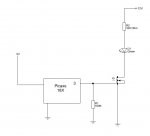Alright, I'm sure there is a really easy explanation for this, but for some reason I'm having trouble with this very simple circuit. Before I decide to hook up a motor and play around with PWM, I wanted to see if I can drive the Logic Level Mosfet I got. So I hooked up the simple circuit I have shown in the schematic.
However, it does not work. The LED does not come on and the voltage that I measure on Pin 3 is about 0.63 volts. I know that the code is running since I set the pin to turn on and off every 5 seconds and it goes from 0.63V to 0.
The type of Logic Level Mosfet I'm using is a STP20NF06L.
Also, I'm using the Revolution programming board to do all this:
http://www.rev-ed.co.uk/docs/CHI030.pdf
Sorry if this has been asked and answered a hundred times. I did a quick search on the forums and I couldn't find anything that would help me out.
If it helps, I hooked the following circuit up without the PIC using a pushbutton switch instead and it worked:
http://brunningsoftware.co.uk/FET.htm
However, it does not work. The LED does not come on and the voltage that I measure on Pin 3 is about 0.63 volts. I know that the code is running since I set the pin to turn on and off every 5 seconds and it goes from 0.63V to 0.
The type of Logic Level Mosfet I'm using is a STP20NF06L.
Also, I'm using the Revolution programming board to do all this:
http://www.rev-ed.co.uk/docs/CHI030.pdf
Sorry if this has been asked and answered a hundred times. I did a quick search on the forums and I couldn't find anything that would help me out.
If it helps, I hooked the following circuit up without the PIC using a pushbutton switch instead and it worked:
http://brunningsoftware.co.uk/FET.htm
Attachments
-
38.1 KB Views: 97
Last edited:

